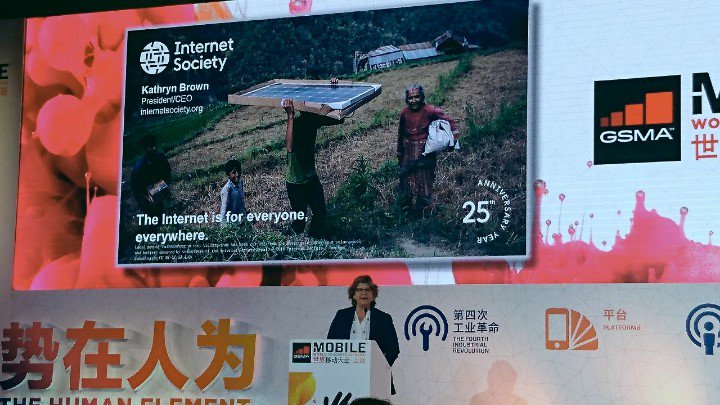On 29 June 2017, Internet Society President and CEO Kathy Brown spoke on a panel on “Society and the Human Element” at the Mobile World Congress (MWC) Shanghai event. These are her remarks as prepared.
See also:
- Video of Kathy’s remarks at MWC Shanghai
- Kathy’s post: Let’s Think Differently to Shape Tomorrow
- An article in the MWC daily newsletter focused on Kathy’s remarks: Mobile industry urged to drive forward digital inclusion
Good morning Ladies and Gentleman,
Let me start by applauding the GSMA for highlighting the importance of the Human Element. The Congress this week is rightly focused on understanding human interaction with technology and what it means for society as we head into the future.
The Internet Society is grateful for the invitation to speak with you this morning.
For 25 years now the Internet Society has been home to a global community of people who are driven by a common idea: that when people get access to the Internet, amazing things can happen.
We can do things like share ideas, build communities, make tools we haven’t even dreamed of, deliver healthcare or help children stay in school.
We believe that everyone, everywhere should have access to the global information network that we know as the Internet.
There is no question that relationship between humans and technology increasingly defines the world around us. One only needs to contemplate the changes in our societies as we become ever more connected. And, there is no question that wireless technology has become a crucial force in building a connected future for us all. Indeed, There are more than 730 million Internet users in China alone, with 95% using mobile devices.
Goals for a Sustainable Future
In 2015 the world made one of the biggest promises it has ever made to itself.
The United Nations set out 17 Global Goals – the Sustainable Development Goals – aimed at achieving extraordinary things in the next 15 years including fighting injustice and inequalities, ending climate change, beating discrimination, bringing in sustainable energy, and making sure no one goes hungry.
We’re now into the second year of working to keep that promise. It’s an enormous task. Rough estimates say we’ll need at least $1 trillion of additional annual investment in developing and emerging economies to achieve the Goals.
It’s numbers like these that have a lot of people wondering if achieving these noble goals is even possible.
The Internet Society says it is.
The Internet itself is an enabler for the Goals. We will be able to get there faster and in a way that lasts, if everyone, everywhere can access to the Internet and benefit from it.
In fact, SDG 9 focuses on the important role infrastructure and connectivity plays in connecting the least connected places on the planet.
Here is the good news: According to a UN report on SDG 9 – in 2016, 95% of the worlds’ population and 85% of people in the least developed countries were covered by a mobile signal.
So, while four billion of the world’s seven billion citizens are not yet connected, we have a real and present opportunity to bring all our people into our shared emerging digital future.
People in this room are dedicating their professional lives to ensuring that those people and places within the “signal range” will soon have access to the world’s most powerful consumer computer – the smart phone.
With 3G, 4G and soon 5G technologies, all of our people will have access to the information network that is unsurpassed in human kind. At the Internet Society, we work alongside commercial providers to build capacity for both personal and institutional use of the technology with programs aimed at both access and affordability.
But what about those who are not “within range”? What about those who live in our rural areas where the cost of building and operating networks does not meet the demands of an unforgiving ROR?
An Approach: Community Networks
I would like to briefly discuss a way of moving forward that we believe is complimentary to the efforts of the mobile industry and which needs very much, your expertise and partnership.
Community Networking offers a way for anyone, anywhere and regardless of background, to be able to connect to the Internet as long as they have the right tools and support.
By empowering people in underserved villages across the world to connect themselves and their communities – community networks provide access where traditional or commercial networks do not reach or serve, or to areas where it may not be economically viable to operate.
They offer a complementary alternative to traditional, commercial telecommunications networks
They also are a way to develop future business by creating “digitally savvy” communities, hungry for more local content and additional services.
These are not super high-tech networks. They serve a local community-driven purpose to connect within and to connect from the village or community “out”. They might be local open-source 2G solutions, or Wi-Fi mesh solutions using license-free spectrum. The aim is to build capacity for both the demand and the supply of digital tools.
We are currently supporting over 20 projects using different technologies to fulfill community needs.
In Nepal, for instance, in partnership with the Nepal Wireless Project, 12 schools, 2 health centers and a community hospital are up and running.
In Talonia, India, we have seen the success of Wireless For Communities – a grassroots project that started in partnership with the Digital Empowerment Foundation that has since been replicated first across Asia and is now moving across the world.
Let me show you a couple of pictures that I think captures the promise of this work.
Partnership
So, how can this scale, you may ask?
Another fascinating aspect of the UN SDG 9 implementation report is the indicator assessing the distance of villages from a public road. In our anecdotal experience, many villages lie within 2 to 5 kilometers from the road. And running down the road? mobile connectivity bouncing from cell to cell. A lifeline? A means of connection?
Could it be that we might be able to connect these villages, one by one to the cellular backbone that is fast being built throughout the developing world? What if…
This I know, the world needs the mobile industry and the Internet community to share the responsibility of supporting those pioneering individuals who are building their own networks.
And, there are ways for each of us and our companies to be part of a global movement of people around the world coming together to make previously impossible progress possible–to make progress scale. Companies here do and can participate by donating time, people, equipment, training, or —providing these innovative projects with backhaul or a slice of unused spectrum.
The Internet Society is keen for us to put our minds and energies together to forge new partnerships and strengthen existing ones.
Let’s shape tomorrow.
Thank you so much for your attention.
Image credit: Rajnesh Singh

